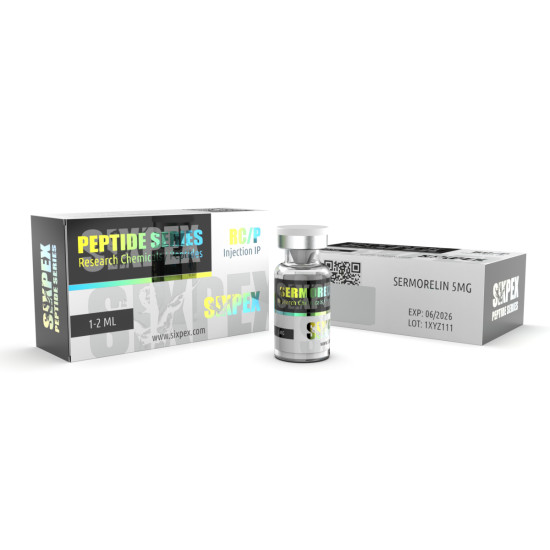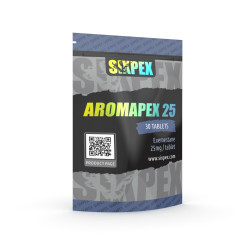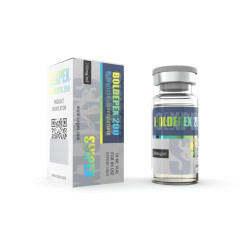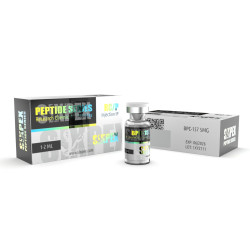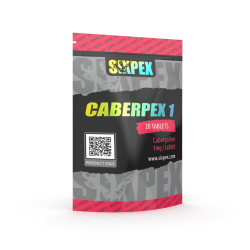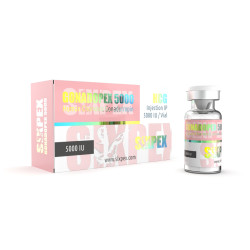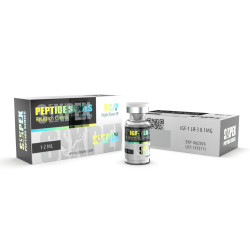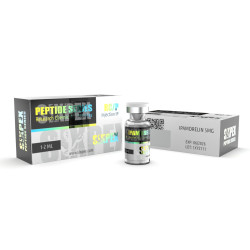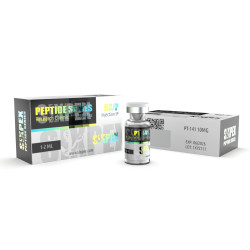Exploring the Usage, Effects, and Side Effects of Sermorelin
1. Introduction to Sermorelin
Sermorelin is a 29-amino acid peptide best known for its involvement in the regulation of growth hormone (GH). It works primarily by stimulating the pituitary gland to release growth hormone. Sermorelin has been in use in medical practices and given subcutaneously to patients for more than 25 years. The first patent was granted for the drug in 1978. As of 2009, it is still under the radar, and doctors and patients are more interested in growth hormone rather than the peptide that stimulates the release of growth hormone because of the marketing by big pharmaceutical companies. This has begun to change over time, as large numbers of Americans transition from the life phase of “youth” to “aging” — hence, the emerging discipline of anti-aging medicine. This essay will delve into “discovery” and “history” in order to gain a better understanding of sermorelin and appreciation for its similarities and differences to growth hormone. From there, this essay will report on what is currently known about sermorelin. Areas of interest include its use in homeopathic and allopathic medicine, safety and efficacy, and side effects associated with sermorelin. Lastly, an essay summary will address the usage of sermorelin in treating growth hormone deficiency, with attention to safety issues and benefits of sermorelin.
1.1. Definition and Mechanism of Action
Sermorelin, sometimes called GRF 1-29, is a synthetic peptide that shares significant structural and functional similarities with GHRH, ensuring a primarily stimulating effect on the pituitary gland, the body's natural growth hormone production center. Peptide receptors determine the pharmacological profile of Sermorelin, leading to its short half-life of 10 minutes after administration. Sermorelin's strictly defined mechanism of action involves binding to specific pituitary gland receptors located on the cell surface, causing cascades of signaling pathways that subsequently activate intracellular components of the signaling pathways. This signal transmission ultimately leads to the modification of certain proteins of the pituitary gland that are responsible for growth hormone synthesis and its release into the body.
Subsequently, stimulating the natural production of GH through the Sermorelin-controlled endocrine pathway, called the "GHRH/IGF-1 axis," provides benefits and privileges in comparison with the so-called GH axis, which is dominated by the use of direct injections of human growth hormone. From a medical and, in a broader sense, an evolutionary point of view, the pathological manipulation of some biochemical pathways and mechanisms of our body with synthetic substances and exogenous factors is always burdened with a safety risk, whereas the elicitation of natural stimulation for our body functions could be considered safer for our health. The increased negativity of the end of training by GHRH compared to direct hGH injection has consequences for the "reinforcement" of the activity of the various biochemical pathways brought in the proliferative signal cascade, which are involved in adverse effects of abuse and prohibited use. Some of these potential adverse effects have also been observed in clinical trials.
2. Clinical Applications of Sermorelin
Sermorelin has been developed primarily for various applications in clinical endocrinology and hormonal therapies. Clinically, the most obvious indications are expected to be related to deficient growth hormone release, such as in children and adults. In growth, GHRH is the primary natural stimulant associated with exercise and is important for the maximal release of growth hormone. In the pediatric population, Sermorelin for growth hormone peptide is used for the treatment of idiopathic short stature and idiopathic growth hormone deficiency, as well as training needed to improve the LH reserve.
In adults, Sermorelin is being utilized increasingly as an alternative to human growth hormone off-label by hormone replacement specialists to help patients build muscle and lose weight, but it does not have the side effects associated with HGH therapy. Sermorelin treatment can safely restore the appropriate physiological body substances. As adjunctive therapy to enhance the effectiveness of obesity treatments, it is becoming increasingly popular. Sermorelin possibly has off-label usage for low serum growth hormone levels that occur due to the age-related decline of growth hormone in old age. Using five case studies over a ten-year period on patients who were treated for growth hormone deficiency, Sermorelin showed significant improvement in mood, energy, and other mental functions.
2.1. Treatment of Growth Hormone Deficiency
When administering Sermorelin, it is technically considered a treatment for growth hormone deficiency (GHD), a condition in which the body does not produce enough growth hormone (GH). In childhood, this can result in dwarfism, and in adulthood, sufferers are more prone to losing muscle, gaining weight, feeling fatigued and unhappy, and are at an elevated risk of metabolic diseases. Clinical diagnosis of GHD in most developed countries requires reaching a specific level of one or more diagnostic tests, such as provocative growth hormone release tests, with a blood glucose level of at least 55-72 ng/dL. This diagnosis must then be confirmed with a second test showing the same GHD status. Otherwise, GHD is considered to be a transient condition or the result of an alternative disease process. If GHD remains untreated, it is often associated with a litany of metabolic symptoms and secondary diseases, such as atherosclerosis, type 2 diabetes, increased visceral adiposity, and hyperlipidemia. In severe cases, it contributes to obesity and a sedentary lifestyle. This growing population in modern societies is at a greater risk of GHD, as they are not getting very physically active or athletic and often consume too many calories, leading to excess body fat accumulation. Early diagnosis and continuing treatment of GHD are essential to maintaining a healthy lifestyle and reducing long-term health complications. A common treatment plan recommended by healthcare professionals is either Sermorelin acetate or growth hormone replacement therapy (GHRT) alone or in combination with other medications. Often, Sermorelin is favored over GHRT for newer patients, but especially for pediatric patients, all healthcare decisions must consider individual needs, age, and disease history to provide proper care before attempting any treatment. Typical Sermorelin dosages for adults are 15–30 mcg per dosage vial, with different concentrations from 5,000 mcgs to 15,000 mcgs per vial injected 15 minutes before breakfast, or pre-bed injections may be used. The dose may be as high as 4-8 IU for bodybuilders or athletes, who often use this drug in combination with other anabolic steroids or performance-enhancing drugs.
3. Benefits of Sermorelin Therapy
Some of the benefits that have been reported include an increase in muscle mass and strength. There has been a significant increase in muscle mass in the arms of study participants. Other benefits of therapy include enhancing physical performance in both training and competition. It may aid in accelerated recovery from workouts and injury. This human growth hormone therapy is used to increase energy levels. Users may notice improved mental acuity, including cognitive skills, with use. It also may enhance mood and an overall feeling of well-being. People who use this therapy report feeling better and having a renewed interest in daily life. It is a known fact that people over the age of 30 are not the same as they are at 20, and that is due to hormonal changes.
This therapy using human growth hormone has an additional benefit: the potential to increase motivation. Patients have reported more get-up-and-go, especially when it comes to exercising and other fitness activities. This has a beneficial effect and carries over into many other areas of life. While some side effects of this therapy are detailed, e.g., skin redness at the administration site is common, most people who are prescribed this form of hormone therapy experience few side effects. Many health professionals recommend further research into these additional benefits as they currently exist, as well as the potential of human growth hormone to advance anti-aging research. The use of this therapy can also lead to tighter skin and a smoother complexion because it increases the production of collagen in the human body.
3.1. Improved Muscle Mass and Strength
One of the most publicized and highly sought-after benefits of using the peptide Sermorelin is improving muscle mass. Being able to not only build muscle but hold onto it as you age is a major part of the reason people use anabolic steroids or testosterone replacement therapies. The benefits of Sermorelin in promoting more lean muscle tissue throughout the body have been conclusively found and are demonstrated through patient results.
Sermorelin directly increases the growth of muscle by promoting an increase in protein synthesis, decreasing protein oxidation, increasing muscle recovery, and decreasing the breakdown of muscle. Sermorelin’s effect on muscle growth is linked to the dosage used. Higher dosages have been shown to have a quicker and more sustained effect on muscle hypertrophy and regeneration. As peptides take time to work and the body takes time to adapt, to achieve the best result through treatment, dosages are best used for at least six months, when combined with appropriate nutrition and training plans. With the continued release of human growth hormone in response to the use of Sermorelin therapy, the benefits to muscle end up being far better when compared to the use of injectable steroids and those that affect testosterone.
There is no doubt that the use of human growth hormone or growth hormone peptides such as Sermorelin is extremely beneficial in promoting the regeneration of muscle, the increased recovery between workouts, improvements that can be made in individual performance, and increased muscle synthesis in response to treatment. However, one thing is clear: Sermorelin is not a magic bullet, and unless combined with the correct diet, proper amounts of sleep, and respite from biochemical and psychological stress, the improvements and evidence around the dosing of Sermorelin will not occur. It is also crucial to acknowledge that much higher doses are required to improve the muscle strength of an individual compared to peptide hormone human growth hormone therapy. Scientists believe that the best way to utilize doses of Sermorelin is to deliver it continuously, matching the bursts that would occur from a sharp hypothalamic pulse to stimulate optimal growth hormone levels. Sermorelin, like all peptides, comes with side effects that should be closely monitored by a medical professional. Despite the potential risks associated with this therapy, clinical evidence suggests that the use of Sermorelin results in improved muscle strength, vitality, libido, body composition, and improved mood.
4. Potential Side Effects of Sermorelin
There are no proven permanent or life-threatening effects of Sermorelin therapy, but clinicians must discuss potential side effects with patients. A majority of the studies of patients treated with Sermorelin have reported improvement in key laboratory and physical parameters, suggesting that the drug has benefits that outweigh its risks. Common side effects of Sermorelin therapy are mild and usually transient. Mild injection site reactions are the most common side effect. These can result in pain, redness, or swelling at the injection site or in the hands or feet. The incidence is estimated to be 5-12% and is slightly higher in male patients. Patients who report these side effects can try other sites for injection. When patients are advised to inject in the morning and do so on an empty stomach, mild reactions are less likely to occur. Patients and their partners should understand how to mix and inject the solution correctly to minimize the risks associated with self-administration. No clinically significant allergic reactions have been reported in response to Sermorelin therapy in adolescents or adults. Clinic staff may want to ask about allergic reactions to diluent or bacteriostatic solution to guide patients. Occasionally, use caution in young patients before puberty begins unless there is a clear and severe growth hormone deficiency. There are three case reports, all in childhood, on a medication originally intended to treat children, hormone replacement during cancer therapy, in which a brain tumor was diagnosed or had been treated with radiation, in which children with apparently normal baseline laboratory data developed seizure disorder while taking Sermorelin or growth hormone. The seizures were described as partial complex, and one child had recurrent status epilepticus. More than one year after discontinuation of Sermorelin, epileptiform and sleep activity on EEG persisted. Further research is needed to conclusively attribute these effects to their cause.
4.1. Injection Site Reactions
One of the biggest concerns patients have is that they don’t know what to expect after starting Sermorelin therapy. When going through the possible side effects of any medication, we typically rank them from most severe to least. In the case of Sermorelin, the most common side effect we experience is injection site reactions. These reactions often cause redness, swelling, or some discomfort at the site. The most severe cases may experience a little tingling; this side effect will subside in just a few minutes to possibly a few hours. These kinds of reactions are not out of the ordinary as they occur in less than half the cases and don’t last long. The truth is that when it comes to any kind of injection, especially one that involves a needle to the body, one can expect that the injection site will become sensitive and sore to the touch.
The first thing that a patient should understand is that this type of reaction during Sermorelin injections is highly typical and over 95% of all patients undergoing this kind of therapy will encounter some form of irritation at the injection site; however, this usually goes away in a short period of time. Therefore, it is a clear sign that one is actually being prescribed and injected with hGH. We administer the shots either daily or weekly. Of course, whatever the advice is from the doctor, in order to follow an astute medical regimen, it's best to do as prescribed rather than try a shorter or a regular amount of time. So for those patients who happen to be handled by our experienced medical professionals and certified physicians, they should be sure to go through with the details of any changes and also use the experience that they have gathered together with the administration of injections to benefit their personal results.
5. Conclusion and Future Directions
Overall, some known benefits of Sermorelin use can include a greater sense of safety, combined with a lower incidence of many health-related issues associated with high or normal levels of HGH when taken over time. There also appear to be no apparent side effects when taken correctly, as it is regulated by the body's own hormone systems. Potential drawbacks to Sermorelin therapy involve frequent dosages and the administration of persisting immune responses, although time will show whether these attitudes toward hormone production boosters are scientifically valid.
We believe that the results of the continuing studies conducted on Sermorelin could support the benefits of Sermorelin treatment, should the therapy's long-term sparing response on aberrant endogenous HGH stay consistent with Sermorelin's initial clinical trials. The delicate interrelationship between hormone dosage, strength, and the user's unique needs, glazed over by the reducing community, may continue to endorse sound clinical advice through the growth of personalized treatment approaches based on genetic biomarkers in hormone and peptide therapy, given enough time and its accurate documentation via surveys and interviews. With the rise in biohacking and hormone therapies investing increasingly in short- and long-term quality of life considerations, combined with the increasing demands from an already flooded consumer base, hormone replacement therapy and HGH/SERM increase therapies will likely continue to gain public acceptance in mainstream anti-aging therapies as other bio-extensions of earlier disclosed bundles of healthy behaviors such as diet and exercise regimens. Health care providers and consumers' endorsement of discrete HGH and young hormone replacement, complemented by hard-hitting PR and common-sense recommendations coming from the medical community, may lead to endorsement for the treatment, or conversely the public's abdication if found too unsafe via clinical trials and long-term animal investigations. Ultimately, any arduous acceptance or progress in clinical testing associated with Sermorelin may come down to a balanced understanding and exploration of the risks and benefits of Sermorelin and other GHRH analogs.

